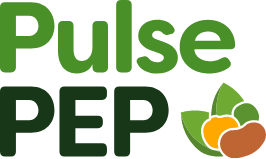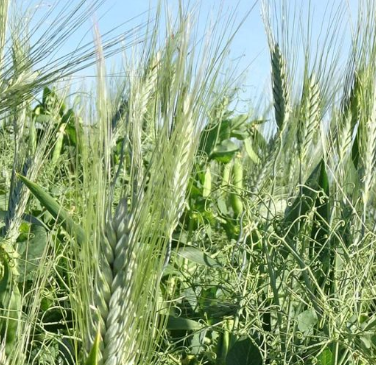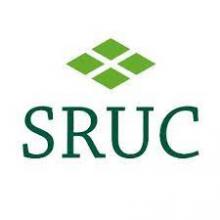By Christine Watson (SRUC)
There has been a growing interest in home produced protein for many years, but European agriculture continues to depend on imported soya for livestock feed.
Did you know?
- Around 14 million tonnes of soya beans and 18 million tonnes soya meal are imported annually to Europe (5 year running mean).
- That represents 13.5 million hectares (ha) of land…
- The EU is 5% self-sufficient in soya bean meal, compared to 79% for rapeseed meal (FEFAC, 2017).
- Soya is an oil crop and the protein is a co-product – that affects its price.
So, what can we do to produce more grain legumes in the UK? In the Legume Gap project, we have been trying to understand why there is a yield gap (meaning a difference in yield) between grain legumes grown on-farm and the potential yield of those crops under ideal conditions. To uncover more about this mystery, we have been talking to people, digging into the literature, modelling crop yields, and doing experiments in 8 countries across Europe. You might even have contributed to our survey!
There is anecdotal evidence that experience matters when it comes to growing grain legumes – don’t give up if the crop isn’t a huge success in year one. Trial results from Aberdeen showed that inoculation of faba bean can really make a difference even though conventional wisdom said it shouldn’t be necessary. We went from a complete crop failure to yields of up to 8.21 tonnes per ha in an organic system by using a suitable inoculant. This is backed up by the literature from across Europe which shows a 1.6-fold increase in yield from using an inoculant. Interestingly, faba beans respond to different tillage regimes with no till systems increasing yields by 25%, while minimum tillage tended to slightly reduce yields. Full results of the survey sharing what farmers in different countries see as barriers and enablers to faba and soya production will be available soon.
Growing grain legumes as intercrops with cereals has the added advantage of increasing the protein content of the companion cereal. For example, in Scottish experiments in 2016, barley grown with beans had a protein content of 13.5% compared with 8.9% when grown alone. The comparable figures were 10.9% for barley grown with lupins and 11.3% for barley grown with peas. Definitely food for thought!
If you are interested in learning more about intercropping then there are an informative set of policy briefs produced by the Horizon 2020 project ReMIX on aspects of intercropping related to crop health, nutrient management and harvesting. Can we harvest intercrops successfully and maintain grain quality? Yes, we can! In the ReMIX project, French colleagues working in INRAe were able to improve the quality and the price of intercropped grains simply by optimising the settings on the combine. Read more on this interesting story here.
Of course, we shouldn’t forget the added value that grain legumes bring to the cropping system. The ability of these crops to utilize or ‘fix’ atmospheric nitrogen via bacteria living in nodules on their root systems (biological nitrogen fixation) means they can help reduce dependence on manufactured nitrogen fertilisers. This can represent a significant saving in financial and environmental terms if you grow legumes one year in every five or six. The amount of nitrogen left behind in the soil for the next crop varies but beans leave more than peas behind them. Of course, nitrogen-rich residues left behind in the soil can also create a risk of losses of nitrogen and this needs careful management. All the grain legumes are very attractive to pollinators and thus help on the biodiversity front. Nor should we forget the ‘break’ crop value of grain legumes in cereal dominated rotations. Not only do they have different disease susceptibility, but in conventional systems they also allow the use of different crop protection chemicals. Unfortunately, no crop is all good news and we do need to be aware of the susceptibility of these crops to pests and diseases.
The knowledge base on grain legume production in the UK and Europe is growing and one great resource that has been developed through the EU project Legumes Translated is the Legume Hub. It has special interest sections on faba bean, lucerne, lupins, peas and soybean, and covers the whole chain from production to consumption by humans and livestock with blogs, vlogs and other good reads. It has been developed by a community meaning that you can become a member of the hub and contribute your knowledge too.
Christine Watson is Professor of Agricultural Systems at SRUC. She writes of herself:
“My career started with a degree in soil science at Reading University. A year out working in an agricultural research laboratory and trying to measure gaseous nitrogen emissions from soil convinced me I would like a career in research. My first job after graduating was working on nutrient cycling on organic farms at Aberystwyth University and from there my interest in, and knowledge of, both organic and conventional agriculture has continued to grow. I moved to Aberdeen and worked on agroforestry at the Macaulay Land Use Research Institute before joining SRUC (then SAC). I am still with SRUC as Professor of Agricultural Systems, but I also hold a guest professorship in the Swedish University of Agricultural Sciences. I continue to be fascinated by soil and nutrient management in both a local and a global context.”
All images courtesy of Christine Watson. All Rights Reserved




